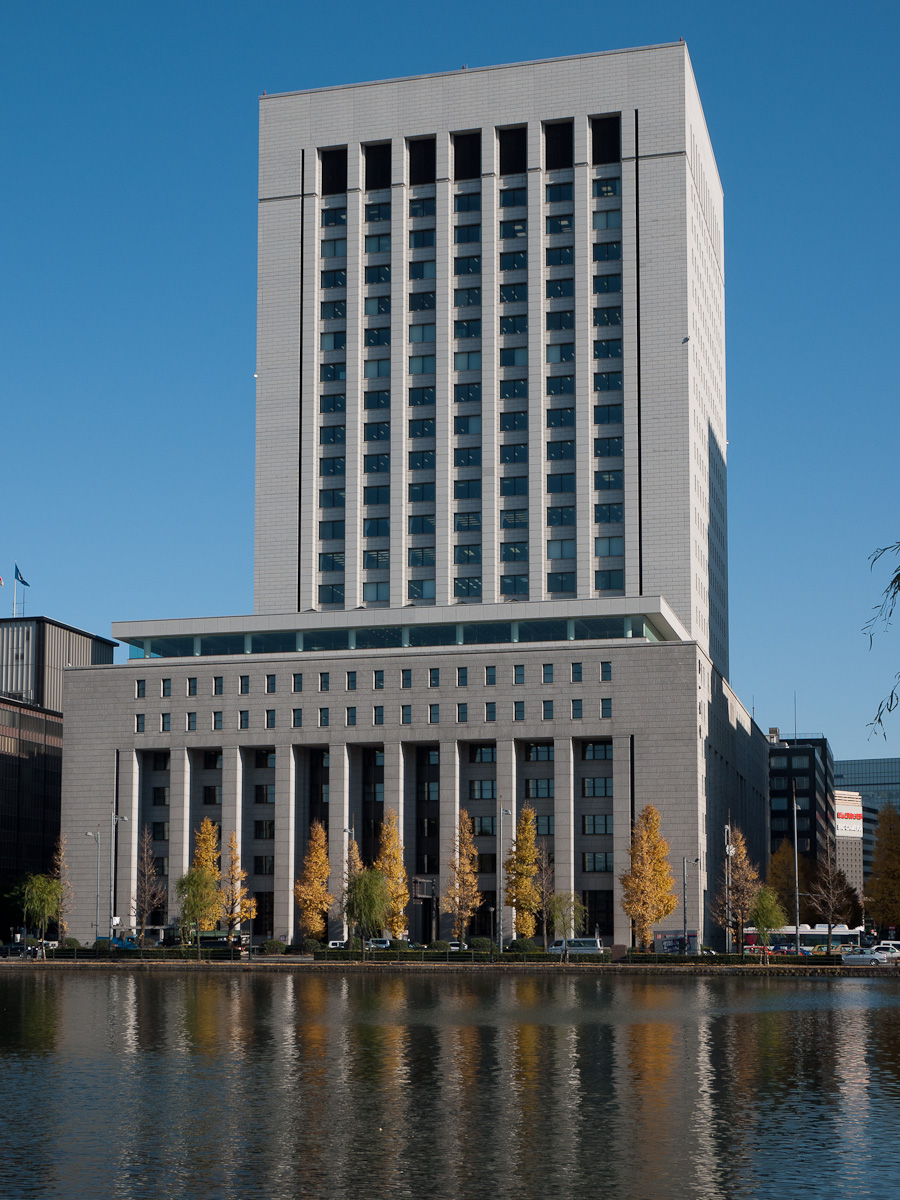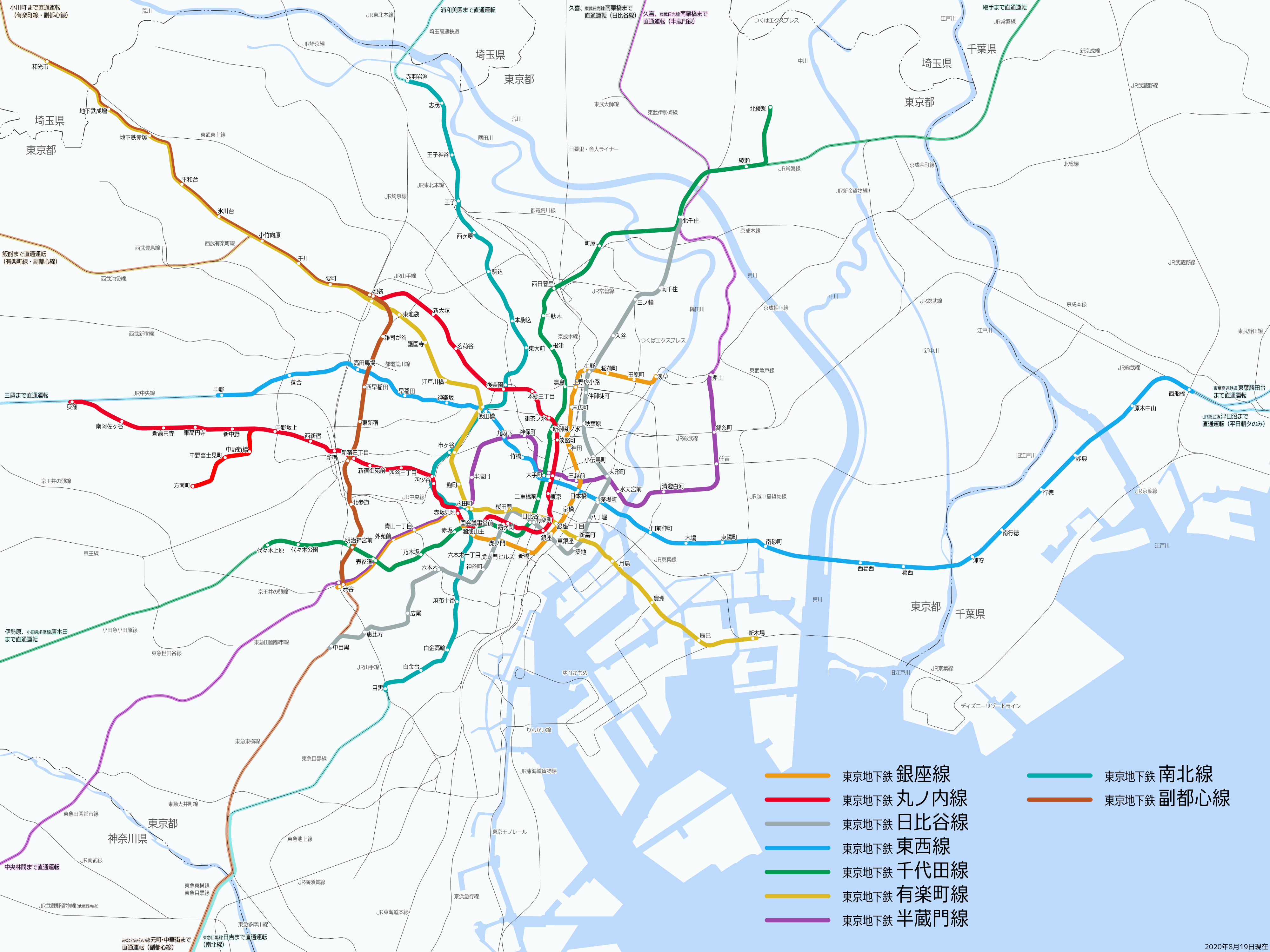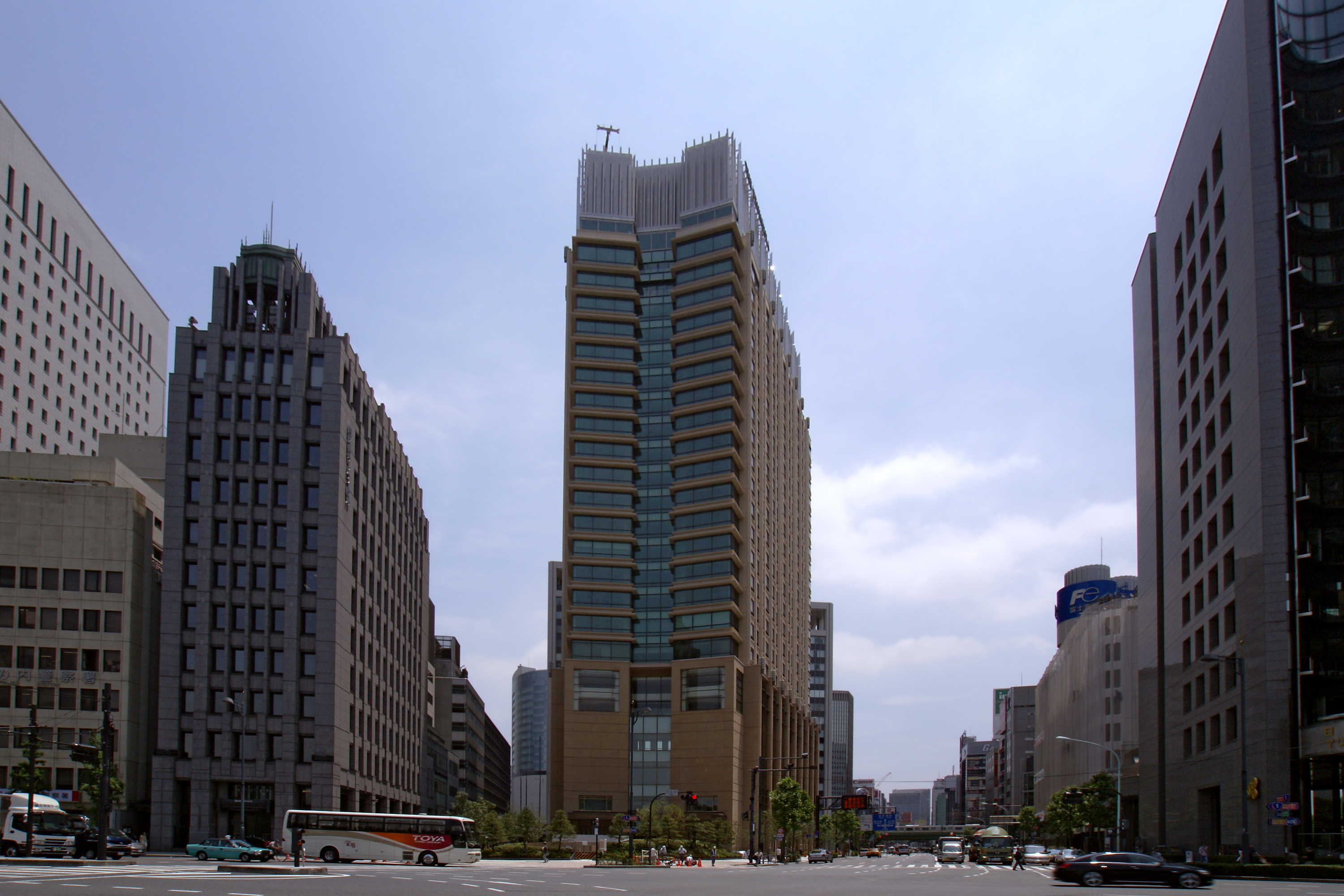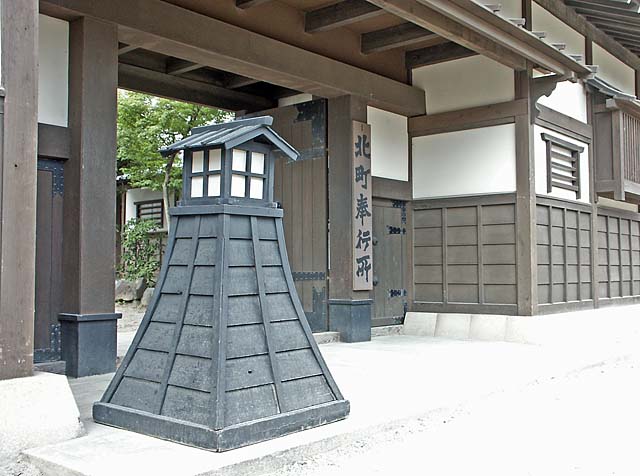|
Yūrakuchō
is a business district of Chiyoda, Tokyo, Japan, situated in between the Ginza and Hibiya Park, southeast of the Tokyo Imperial Palace. The district takes its name from Oda Nagamasu (1547–1622), who was also known as Yūraku (有楽). Oda Nagamasu built his mansion here on land granted by Tokugawa Ieyasu near the Sukiya-bashi Gate of Edo Castle. The place name dates from the Meiji period. Yūrakuchō is served by several train and subway stations, including Hibiya Station (Toei Subway and Tokyo Metro lines) and Yūrakuchō Station (JR East and Tokyo Metro lines). Unlike its tonier neighbor Ginza, Yūrakuchō provides a glimpse of Japanese life from the early postwar period, with its many ''izakaya'' (Japanese-style bars, denoted by their red lanterns known as ''Traditional lighting equipment of Japan, akachochin'') and outdoor ''yakitori'' restaurants, many of which are located near or under the train tracks serving Tokyo's Japan Railways Group, JR Yamanote Line. Because of it ... [...More Info...] [...Related Items...] OR: [Wikipedia] [Google] [Baidu] |
Tokyo Metro
The Tokyo Metro () is a major rapid transit system in Tokyo, Japan, operated by the #Organization, Tokyo Metro Co. With an average daily ridership of 6.52 million passengers (as of 2023), the Tokyo Metro is the larger of the Tokyo subway, two subway operators in the city, the other being the Toei Subway, with 2.85 million average daily rides. Organization Tokyo Metro is operated by , a joint-stock company jointly owned by the Government of Japan and the Tokyo Metropolitan Government. The company, founded as a part of then-Prime Minister Junichiro Koizumi's policy of converting statutory corporations into Joint-stock company, joint-stock companies, replaced the , commonly known as Eidan or TRTA, on April 1, 2004. TRTA was administered by the Ministry of Land, Infrastructure and Transport (Japan), Ministry of Land, Infrastructure and Transport, and jointly funded by the national and metropolitan governments. It was formed in 1941 as a part-nationalization of the Tokyo Undergrou ... [...More Info...] [...Related Items...] OR: [Wikipedia] [Google] [Baidu] |
Yūrakuchō Station
is a railway station in the Yūrakuchō district of Chiyoda, Tokyo, Japan, operated by East Japan Railway Company (JR East) and the Tokyo subway operator Tokyo Metro. It is Tokyo Metro's fifteenth busiest station in 2016. Lines Yūrakuchō is served by the JR East Keihin-Tōhoku Line and Yamanote Line, and the Tokyo Metro Yūrakuchō Line subway. On Tokyo subway maps, nearby Hibiya Station is marked as an interchange and is linked to Yurakucho by underground passages. Platforms JR East platforms File:JRE Yurakucho-STA Platform1-2.jpg, Platforms 1 and 2 File:JRE Yurakucho-STA Platform3-4.jpg, Platforms 3 and 4 Tokyo Metro platforms File:TokyoMetro-yurakucho-platform.jpg, Yurakucho Line platforms History The elevated JR station opened on June 25, 1910. The subway station opened on October 30, 1974. Chest-high platform edge doors Platform screen doors (PSDs), also known as platform edge doors (PEDs), are used at some train, rapid transit and people mover ... [...More Info...] [...Related Items...] OR: [Wikipedia] [Google] [Baidu] |
Hibiya Station
is a Tokyo subway station in the Yūrakuchō district of Chiyoda, Tokyo, Japan, operated by Tokyo Metro and Toei. The area around the station is generally called Hibiya, which is the southwestern corner of the Yūrakuchō district. Hibiya is Tokyo Metro's 33rd busiest station in fiscal 2019, while its connected station Yūrakuchō ranks sixteenth. Lines * Tokyo Metro Chiyoda Line (C-09) * Tokyo Metro Hibiya Line (H-08) * Toei Mita Line (I-08) Yūrakuchō Station on the Tokyo Metro Yūrakuchō Line is connected to Hibiya Station by underground passageways, and it is possible to connect between the two stations without going through the ticket gates. However, the JR platforms at Yūrakuchō are fairly far from Hibiya Station and require a second ticket. Station layout Tokyo Metro platforms Toei platforms File:Tokyo-Metro Hibiya-STA Platform1.jpg, Hibiya Line platforms, 2023 File:Tokyo-Metro Hibiya-STA Platform3-4.jpg, Chiyoda Line platforms, 2023 File:Toei-subway-I08-Hi ... [...More Info...] [...Related Items...] OR: [Wikipedia] [Google] [Baidu] |
Tokyo Station
Tōkyō Station (, ) is a major railway station in Chiyoda, Tokyo, Japan. The original station is located in Chiyoda's Marunouchi business district near the Tokyo Imperial Palace, Imperial Palace grounds. The newer Eastern extension is not far from the Ginza commercial district. Due to the large area covered by the station, it is divided into the Marunouchi (west) and Yaesu (east) sides in its directional signage. The station opened in 1914 as an integrated terminus for the present-day Tōkaidō Main Line, Tōkaidō Line, Tōhoku Main Line, Tōhoku Line, and later the Chūō Main Line, Chūō Line, which previously had separate termini in Tokyo. Since then, it has served as the main terminus for inter-city trains departing Tokyo westwards. The station was badly damaged during the Bombing of Tokyo on 25 May 1945 but soon resumed service. The Tokaido Shinkansen, Tōkaidō Shinkansen, the world’s first dedicated high-speed rail system, opened between the station and Osaka in 196 ... [...More Info...] [...Related Items...] OR: [Wikipedia] [Google] [Baidu] |
Hibiya
is a colloquial name for a neighborhood of Chiyoda, Tokyo, Chiyoda Ward in Tokyo. The area along Hibiya Street (Japan National Route 1, National Route 1) from Yūrakuchō to Uchisaiwaichō is generally considered Hibiya district. Administratively, it is part of the Yūrakuchō district. There is no actual administrative district in Chiyoda called "Hibiya" but the name is used in some local place names such as Hibiya Park and Hibiya Station (administratively in Yūrakuchō). Hibiya was part of the old Kōjimachi ward in Tokyo City, before it was transformed into a metropolis. Etymology The outskirts of this district are land reclamation, reclaimed from the ocean, and the "hibi" of Hibiya is derived from the facility for the laver of nori made of bamboo, whose name is also "hibi". This effectively makes the word an ateji, kanji characters used to phonetically represent native Japanese words. History Originally an inlet of the sea ran northwards to a cove at present-day Hi ... [...More Info...] [...Related Items...] OR: [Wikipedia] [Google] [Baidu] |
Ginza
Ginza ( ; ) is a district of Chūō, Tokyo, Chūō, Tokyo, located south of Yaesu and Kyōbashi, Tokyo, Kyōbashi, west of Tsukiji, east of Yūrakuchō and Uchisaiwaichō, and north of Shinbashi. It is a popular upscale shopping area of Tokyo, with numerous internationally renowned department stores, boutiques, restaurants and coffeehouses located in its vicinity. It is considered to be one of the most expensive, elegant, and luxurious city districts in the world. Ginza was a part of the old Kyobashi ward of Tokyo City, which, together with Nihonbashi and Kanda, Tokyo, Kanda, formed the core of Shitamachi, the original downtown center of Edo (Tokyo). History Ginza was built upon a former swamp that was filled in during the 16th century. The name Ginza comes after the establishment of a silver-coin mint (coin), mint established there in 1612, during the Edo period. After a devastating fire in 1872 burned down most of the area, the Meiji government designated the Ginza are ... [...More Info...] [...Related Items...] OR: [Wikipedia] [Google] [Baidu] |
Yamanote Line
The Yamanote Line () is a railway Circle route, loop service in Tokyo, Japan, operated by the East Japan Railway Company (JR East). It is one of Tokyo's busiest and most important lines, connecting most of Tokyo's major stations and urban centres, including Marunouchi, the Yūrakuchō/Ginza area, Shinagawa, Shibuya, Tokyo, Shibuya, Shinjuku, Ikebukuro, and Ueno, Tokyo, Ueno, with all but two of its 30 stations connecting to other railway or underground (subway) lines. Internally JR East refers to the "Yamanote Line" as the Quadruple-track railway, quadruple-track corridor between Shinagawa and Tabata Station (Tokyo), Tabata via Shinjuku. The corridor consists of a pair of tracks used by Yamanote local trains and another parallel pair of tracks called "the Yamanote Freight Line" used by the Saikyō Line, Saikyō and Shōnan-Shinjuku Line, Shōnan-Shinjuku line trains, some limited express services, and freight trains. In everyday usage, branding on maps and station signage, the "Y ... [...More Info...] [...Related Items...] OR: [Wikipedia] [Google] [Baidu] |
Chiyoda, Tokyo
, known as Chiyoda City in English, ." ''City of Chiyoda''. Retrieved on December 28, 2008. is a Special wards of Tokyo, special ward of Tokyo, Japan. Located in the heart of Tokyo's 23 special wards, Chiyoda consists of Tokyo Imperial Palace, the Imperial Palace and a surrounding radius of about a kilometer (1000 yards), and is known as the political and financial center of Japan. As of October 2020, the ward has a population of 66,680, and a population density of 5,709 people per km2 (14,786 per sq. mi.), making it by far the least populated of the special wards. The residential part of Chiyoda is at the heart of Yamanote and Shitamachi, Yamanote, Tokyo's traditional upper-class residential area, with Banchō, Kōjimachi, and Kioichō, Chiyoda, Tokyo, Kioichō considered the most exclusive neighbourhoods in the entire city. ... [...More Info...] [...Related Items...] OR: [Wikipedia] [Google] [Baidu] |
Edo Machi-bugyō
were magistrates or municipal administrators with responsibility for governing and maintaining order in the shogunal city of Edo. Machi-bugyō were samurai officials of the Tokugawa shogunate in Edo period Japan. Appointments to this prominent office were usually ''hatamoto'',Cunningham p. 39./ref> this was amongst the senior administrative posts open to those who were not ''daimyōs''.Beasley, William G. (1955). ''Select Documents on Japanese Foreign Policy, 1853–1868'', p. 325. Conventional interpretations have construed these Japanese titles as "commissioner", "overseer" or "governor." During the Edo period, there were generally two hatamoto serving simultaneously as Edo ''machi-bugyō''. There were two Edo ''machi-bugyō-sho'' within the jurisdictional limits of metropolitan Edo; and during the years from 1702 though 1719, there was also a third appointed ''machi-bugyō''.Cunningham, Don. (2004) ''Taiho-Jutsu: Law and Order in the Age of the Samurai'', p. 39./ref> The Edo ... [...More Info...] [...Related Items...] OR: [Wikipedia] [Google] [Baidu] |
The Peninsula Tokyo
The Peninsula Tokyo is a 24-story luxury hotel located in Yurakucho, Chiyoda, Tokyo, Japan. Ownership The hotel is operated by The Peninsula Hotel Group, and is the only Peninsula branded Hotel in Japan. It is owned by Hong Kong and Shanghai Hotels. Awards In January 2012, the Peninsula Tokyo was awarded as the second best hotel in the world by American travel magazine Travel + Leisures annual '500 Best Hotels' List, only being beaten by the Mandarin Oriental, Tokyo, also in Japan. The Spa at the hotel was also awarded the 2011 Readers Choice award for favourite Spa in Japan by Spa Finder USA. Architecture The hotel is also the first free-standing luxury hotel to be built in Tokyo in more than 10 years with direct street access, and it is described as 'international in design, but Japanese by inspiration.' Charity The hotel is involved in Breast Cancer awareness and proudly supports the Japan Breast Cancer Screening Society. Restaurants and bars *The Lobby *He ... [...More Info...] [...Related Items...] OR: [Wikipedia] [Google] [Baidu] |
Oda Nagamasu
was a Japanese daimyō and a brother of Oda Nobunaga who lived from the late Sengoku period through the early Edo period. Also known as or , the Tokyo neighborhood Yūrakuchō is named for him. Nagamasu converted to Christianity in 1588 and took the baptismal name of John. Biography His childhood name was Gengorō (源五郎) and he was the 11th son of Oda Nobuhide. In 1574, he received the Chita District in Owari and the construction of Ōkusa Castle. Later, he was commissioned to serve Oda Nobutada in the Siege of Iwamura (1575), Siege of Shigisan (1577), Siege of Itami (1579), Siege of Takato (1582) and Battle of Tenmokuzan (1582). Nagamasu was an accomplished practitioner of the Japanese tea ceremony, which he studied under the master, Sen no Rikyū. He eventually started his own school of the tea ceremony. In June 1582, during the incident at Honnō-ji, he was one of the vassals of Nobutada in Nijō Castle, he was able to survive and fled to Gifu Castle ... [...More Info...] [...Related Items...] OR: [Wikipedia] [Google] [Baidu] |
DN Tower 21
DN Tower 21"D" stands for Dai-ichi Life, Dai-ichi Life and "N" stands for the Norinchukin Bank, Norinchukin Bank is an office building in Tokyo, Japan. It includes the former Dai-ichi Life, Dai-Ichi Seimei Building, in which Douglas MacArthur had his Supreme Commander for the Allied Powers, headquarters during the occupation of Japan following World War II. The Government of Tokyo designated DN Tower 21 as a historical building in 2004. The shorter five-story building, the former headquarters of Supreme Commander for the Allied Powers, SCAP, was completed in 1933 (renovated 1989–1995) for the headquarters of the Norinchukin Bank, and the Dai-Ichi Seimei began to house its offices in the building in 1938. The shorter building was designed by the Japanese architect Jin Watanabe (architect), Jin Watanabe and Yosaku Matsumoto. The taller 21-story building (at 99.8 metres in height) began construction in 1988 and was completed in 1993, and was designed by the Irish-American architec ... [...More Info...] [...Related Items...] OR: [Wikipedia] [Google] [Baidu] |








